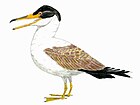Fukuivenator: Difference between revisions
Prowlbeast (talk | contribs) →References: Added Categories Tags: Reverted Mobile edit Mobile web edit |
|||
| (7 intermediate revisions by 3 users not shown) | |||
| Line 2: | Line 2: | ||
{{use dmy dates|date=December 2016}} |
{{use dmy dates|date=December 2016}} |
||
{{speciesbox |
{{speciesbox |
||
| fossil_range = [[Early Cretaceous]], {{fossilrange| |
| fossil_range = [[Early Cretaceous]], {{fossilrange|125|115}} |
||
| image = Fukui Prefectural Dinosaur Museum 20210504 23.jpg |
| image = Fukui Prefectural Dinosaur Museum 20210504 23.jpg |
||
| image_caption = Reconstructed skeleton |
| image_caption = Reconstructed skeleton |
||
| Line 64: | Line 64: | ||
|1=[[Deinonychosauria]] |
|1=[[Deinonychosauria]] |
||
|2=[[Avialae]]}}}}}}}}}}}}}}}}}}}}}}}} |
|2=[[Avialae]]}}}}}}}}}}}}}}}}}}}}}}}} |
||
Another enigmatic maniraptoran, ''[[Migmanychion]]'', is supported as the closest taxon to ''Fukuivenator'' based on phylogenetic analyses:<ref>{{Cite journal |last1=Wang |first1=Xuri |last2=Cau |first2=Andrea |last3=Wang |first3=Zhengdong |last4=Yu |first4=Kaifeng |last5=Wu |first5=Wenhao |last6=Wang |first6=Yang |last7=Liu |first7=Yichuan |date=2023-06-05 |title=A new theropod dinosaur from the Lower Cretaceous Longjiang Formation of Inner Mongolia (China) |journal=[[Cretaceous Research]] |volume=151 |language=en |pages=105605 |doi=10.1016/j.cretres.2023.105605 |issn=0195-6671|doi-access=free }}</ref> |
|||
{{clade |
|||
|{{clade |
|||
|label1=[[Tyrannosauroidea]] |
|||
|1={{clade |
|||
|1=''[[Guanlong]]'' <div style="{{MirrorH}}">[[File:Guanlong wucaii by durbed.jpg|65px]]</div> |
|||
|2={{clade |
|||
|1=''[[Tanycolagreus]]'' <div style="{{MirrorH}}">[[File:Tanycolagreus reconstruction.png|80px]]</div> |
|||
|2=''[[Coelurus]]'' [[File:Coelurus BW.jpg|80px]]}} }} |
|||
|3={{clade |
|||
|1={{clade |
|||
|1=''[[Ornitholestes]]'' <div style="{{MirrorH}}">[[File:Ornitholestes reconstruction.png|80px]]</div> |
|||
|2={{clade |
|||
|1=[[Therizinosauroidea]] <div style="{{MirrorH}}">[[File:Therizinosaurus Restoration.png|70px]]</div> |
|||
|2={{clade |
|||
|1={{clade |
|||
|1=''[[Migmanychion]]'' [[File:Migmanychion UDL.png|80px]] |
|||
|2='''''Fukuivenator''''' <div style="{{MirrorH}}">[[File:Fukuivenator (Therizinosauria).png|80px]]</div> }} |
|||
|3={{clade |
|||
|1={{clade |
|||
|1=[[Ornithomimosauria]] <div style="{{MirrorH}}">[[File:Qiupalong Restoration.png|75px]]</div> |
|||
|2=[[Alvarezsauroidea]] <div style="{{MirrorH}}">[[File:Mononykus Restoration.png|75px]]</div> }} |
|||
|label3=[[Pennaraptora]] |
|||
|3={{clade |
|||
|1=[[Oviraptorosauria]] <div style="{{MirrorH}}">[[File:Citipati osmolskae Restoration.png|70px]]</div> |
|||
|label2=[[Paraves]] |
|||
|2={{clade |
|||
|1=[[Dromaeosauridae]] <div style="{{MirrorH}}">[[File:Deinonychus ewilloughby.png|85px]]</div> |
|||
|2={{clade |
|||
|1=[[Troodontidae]] <div style="{{MirrorH}}">[[File:Zanabazar.jpg|70px]]</div> |
|||
|2=[[Avialae]] [[File:Meyers grosses Konversations-Lexikon - ein Nachschlagewerk des allgemeinen Wissens (1908) (Antwerpener Breiftaube).jpg|35px]] |
|||
}} }} }} }} }} }} }} }} }}|label1=[[Coelurosauria]]}} |
|||
==Paleobiology== |
==Paleobiology== |
||
| Line 82: | Line 116: | ||
{{Taxonbar|from=Q22927446}} |
{{Taxonbar|from=Q22927446}} |
||
[[Category: |
[[Category:Maniraptora]] |
||
[[Category:Fossil taxa described in 2016]] |
[[Category:Fossil taxa described in 2016]] |
||
[[Category:Fossils of Japan]] |
|||
[[Category:Early Cretaceous dinosaurs of Asia]] |
[[Category:Early Cretaceous dinosaurs of Asia]] |
||
[[Category: |
[[Category:Dinosaurs of Japan]] |
||
[[Category:Early Cretaceous vertebrates of Asia]] |
|||
[[Category:Early Cretaceous tetrapods of Asia]] |
|||
Latest revision as of 07:57, 17 October 2024
| Fukuivenator Temporal range: Early Cretaceous,
| |
|---|---|

| |
| Reconstructed skeleton | |
| Scientific classification | |
| Domain: | Eukaryota |
| Kingdom: | Animalia |
| Phylum: | Chordata |
| Clade: | Dinosauria |
| Clade: | Saurischia |
| Clade: | Theropoda |
| Clade: | Maniraptoriformes |
| Clade: | Maniraptora |
| Genus: | †Fukuivenator Azuma et al., 2016 |
| Species: | †F. paradoxus
|
| Binomial name | |
| †Fukuivenator paradoxus Azuma et al., 2016
| |
Fukuivenator ("hunter of Fukui Prefecture") is an extinct genus of maniraptoran theropod dinosaur from the Early Cretaceous of Japan.
Discovery and naming
[edit]
The type species Fukuivenator paradoxus was named and described in 2016 by Yoichi Azuma, Xu Xing, Masateru Shibata, Soichiro Kawabe, Kazunori Miyata and Takuya Imai. The generic name combines a reference to the Fukui prefecture with Latin venator, "hunter". The specific name refers to the paradoxical combination of traits shown by the species.
The rocks in which the skeleton of Fukuivenator, holotype FPDM-V8461, was found in August 2007 belong to the Kitadani Formation, which is probably of Barremian or Aptian age. Radiometric dating of nearby rock units has given this formation an estimated age of somewhere between 127 and 115 million years old. The holotype consists of a partial skeleton with skull. The skeleton of F. paradoxus is currently the most complete non-avian dinosaur fossil found in Japan. The remains, including about 160 bones and bone fragments, were not found in articulation and recovered from an area of 50 by 50 centimetres (20 in × 20 in).[1]
Description
[edit]
Fukuivenator had an estimated length of 2.45 metres (8.0 ft) and an estimated weight of 25 kilograms (55 lb). Distinctive traits include spatulate teeth in the front praemaxillae, pointed, recurved and unserrated teeth in the maxillae and a long neck with elongated neck vertebrae.[1]
Classification
[edit]
The anatomy of Fukuivenator shows a unique combination of primitive and advanced coelurosaurian features. A phylogenetic analysis performed by the research team that described Fukuivenator found it to be a primitive member of the group Maniraptoriformes, in an unresolved position equally closely related to ornithomimosaurs, maniraptorans, and Ornitholestes. Several similarities with the Dromaeosauridae were explained as a case of convergent evolution.[1] A 2021 study determined it a basal member of the therizinosaurs, as shown below:[2]
Another enigmatic maniraptoran, Migmanychion, is supported as the closest taxon to Fukuivenator based on phylogenetic analyses:[3]
Paleobiology
[edit]
Diet
[edit]Because of the long neck and the heterodont unserrated teeth, the probably foremost of which had flattened outer ends, the describing authors suggested that Fukuivenator was no longer a pure carnivore but had adapted itself to a herbivorous or at least omnivorous diet.[1]
See also
[edit]References
[edit]- ^ a b c d Azuma, Y., Xu X., Shibata, M., Kawabe, S., Miyata, K., and Imai, T. 2016. "A bizarre theropod from the Early Cretaceous of Japan highlighting mosaic evolution among coelurosaurians". Scientific Reports, 6(20478). doi:10.1038/srep20478
- ^ Hattori, S.; Kawabe, S.; Imai, T.; Shibata, M.; Miyata, K.; Xu, X.; Azuma, Y. (2021). "Osteology of Fukuiraptor paradoxus: A bizarre maniraptoran theropod from the Early Cretaceous of Fukui, Japan" (PDF). Memoir of the Fukui Prefectural Dinosaur Museum. 20: 1–82.
- ^ Wang, Xuri; Cau, Andrea; Wang, Zhengdong; Yu, Kaifeng; Wu, Wenhao; Wang, Yang; Liu, Yichuan (5 June 2023). "A new theropod dinosaur from the Lower Cretaceous Longjiang Formation of Inner Mongolia (China)". Cretaceous Research. 151: 105605. doi:10.1016/j.cretres.2023.105605. ISSN 0195-6671.










